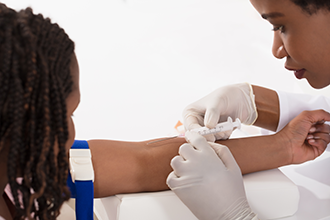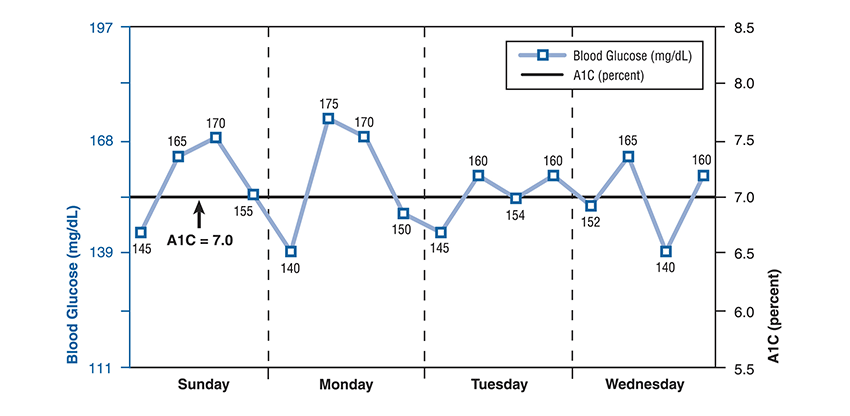The A1C Test & Diabetes
On this page:
- What is the A1C test?
- Why should a person get the A1C test?
- How is the A1C test used to diagnose type 2 diabetes and prediabetes?
- Is the A1C test used during pregnancy?
- Can other blood glucose tests be used to diagnose type 2 diabetes and prediabetes?
- Can the A1C test result in a different diagnosis than the blood glucose tests?
- Why do diabetes blood test results vary?
- How precise is the A1C test?
- How is the A1C test used after diagnosis of diabetes?
- What A1C goal should I have?
- How does A1C relate to estimated average glucose?
- Will the A1C test show short-term changes in blood glucose levels?
- Clinical Trials for the A1C Test and Diabetes
What is the A1C test?
The A1C test is a blood test that provides information about your average levels of blood glucose, also called blood sugar, over the past 3 months. The A1C test can be used to diagnose type 2 diabetes and prediabetes.1 The A1C test is also the primary test used for diabetes management.

The A1C test is sometimes called the hemoglobin A1C, HbA1c, glycated hemoglobin, or glycohemoglobin test. Hemoglobin is the part of a red blood cell that carries oxygen to the cells. Glucose attaches to or binds with hemoglobin in your blood cells, and the A1C test is based on this attachment of glucose to hemoglobin.
The higher the glucose level in your bloodstream, the more glucose will attach to the hemoglobin. The A1C test measures the amount of hemoglobin with attached glucose and reflects your average blood glucose levels over the past 3 months.
The A1C test result is reported as a percentage. The higher the percentage, the higher your blood glucose levels have been. A normal A1C level is below 5.7 percent.
Why should a person get the A1C test?
Testing can help health care professionals
- find prediabetes and counsel you about lifestyle changes to help you delay or prevent type 2 diabetes
- find type 2 diabetes
- work with you to monitor the disease and help make treatment decisions to prevent complications
If you have risk factors for prediabetes or diabetes, talk with your doctor about whether you should be tested.

How is the A1C test used to diagnose type 2 diabetes and prediabetes?
Health care professionals can use the A1C test alone or in combination with other diabetes tests to diagnose type 2 diabetes and prediabetes. You don’t have to fast before having your blood drawn for an A1C test, which means that blood can be drawn for the test at any time of the day.
If you don’t have symptoms but the A1C test shows you have diabetes or prediabetes, you should have a repeat test on a different day using the A1C test or one of the other diabetes tests to confirm the diagnosis.2
A1C results and what the numbers mean
| Diagnosis* | A1C Level |
|---|---|
| Normal | below 5.7 percent |
| Prediabetes | 5.7 to 6.4 percent |
| Diabetes | 6.5 percent or above |
When using the A1C test for diagnosis, your doctor will send your blood sample taken from a vein to a lab that uses an NGSP-certified method. The NGSP, formerly called the National Glycohemoglobin Standardization Program, certifies that makers of A1C tests provide results that are consistent and comparable with those used in the Diabetes Control and Complications Trial.
Blood samples analyzed in a doctor’s office or clinic, known as point-of-care tests, should not be used for diagnosis.
The A1C test should not be used to diagnose type 1 diabetes, gestational diabetes, or cystic fibrosis-related diabetes. The A1C test may give false results in people with certain conditions.
Having prediabetes is a risk factor for developing type 2 diabetes. Within the prediabetes A1C range of 5.7 to 6.4 percent, the higher the A1C, the greater the risk of diabetes.
Is the A1C test used during pregnancy?
Health care professionals may use the A1C test early in pregnancy to see if a woman with risk factors had undiagnosed diabetes before becoming pregnant. Since the A1C test reflects your average blood glucose levels over the past 3 months, testing early in pregnancy may include values reflecting time before you were pregnant. The glucose challenge test or the oral glucose tolerance test (OGTT) are used to check for gestational diabetes, usually between 24 and 28 weeks of pregnancy. If you had gestational diabetes, you should be tested for diabetes no later than 12 weeks after your baby is born. If your blood glucose is still high, you may have type 2 diabetes. Even if your blood glucose is normal, you still have a greater chance of developing type 2 diabetes in the future and should get tested every 3 years.
Can other blood glucose tests be used to diagnose type 2 diabetes and prediabetes?
Yes. Health care professionals also use the fasting plasma glucose (FPG) test and the OGTT to diagnose type 2 diabetes and prediabetes. For these blood glucose tests used to diagnose diabetes, you must fast at least 8 hours before you have your blood drawn. If you have symptoms of diabetes, your doctor may use the random plasma glucose test, which doesn’t require fasting. In some cases, health care professionals use the A1C test to help confirm the results of another blood glucose test.
Can the A1C test result in a different diagnosis than the blood glucose tests?
Yes. In some people, a blood glucose test may show diabetes when an A1C test does not. The reverse can also occur—an A1C test may indicate diabetes even though a blood glucose test does not. Because of these differences in test results, health care professionals repeat tests before making a diagnosis.
People with differing test results may be in an early stage of the disease, when blood glucose levels have not risen high enough to show up on every test. In this case, health care professionals may choose to follow the person closely and repeat the test in several months.
Why do diabetes blood test results vary?
Lab test results can vary from day to day and from test to test. This can be a result of the following factors:
Blood glucose levels move up and down
Your results can vary because of natural changes in your blood glucose level. For example, your blood glucose level moves up and down when you eat or exercise. Sickness and stress also can affect your blood glucose test results. A1C tests are less likely to be affected by short-term changes than FPG or OGTT tests.
The following chart shows how multiple blood glucose measurements over 4 days compare with an A1C measurement.
Blood Glucose Measurements Compared with A1C Measurements over 4 Days

The straight black line shows an A1C measurement of 7.0 percent. The blue line shows an example of how blood glucose test results might look from self-monitoring four times a day over a 4-day period.
A1C tests can be affected by changes in red blood cells or hemoglobin
Conditions that change the life span of red blood cells, such as recent blood loss, sickle cell disease, erythropoietin treatment, hemodialysis, or transfusion, can change A1C levels.
A falsely high A1C result can occur in people who are very low in iron; for example, those with iron-deficiency anemia. Other causes of false A1C results include kidney failure or liver disease.
If you’re of African, Mediterranean, or Southeast Asian descent or have family members with sickle cell anemia or a thalassemia, an A1C test can be unreliable for diagnosing or monitoring diabetes and prediabetes. People in these groups may have a different type of hemoglobin, known as a hemoglobin variant, which can interfere with some A1C tests. Most people with a hemoglobin variant have no symptoms and may not know that they carry this type of hemoglobin. Health care professionals may suspect interference—a falsely high or low result—when your A1C and blood glucose test results don’t match.

Not all A1C tests are unreliable for people with a hemoglobin variant. People with false results from one type of A1C test may need a different type of A1C test to measure their average blood glucose level. The NGSP provides information for health care professionals about which A1C tests are appropriate to use for specific hemoglobin variants.
Read about diabetes blood tests for people of African, Mediterranean, or Southeast Asian descent. The NIDDK has information for health care providers on Sickle Cell Trait & Other Hemoglobinopathies & Diabetes.
Small changes in temperature, equipment, or sample handling
Even when the same blood sample is repeatedly measured in the same lab, the results may vary because of small changes in temperature, equipment, or sample handling. These factors tend to affect glucose measurements—fasting and OGTT—more than the A1C test.

Health care professionals understand these variations and repeat lab tests for confirmation. Diabetes develops over time, so even with variations in test results, health care professionals can tell when overall blood glucose levels are becoming too high.
How precise is the A1C test?
When repeated, the A1C test result can be slightly higher or lower than the first measurement. This means, for example, an A1C reported as 6.8 percent on one test could be reported in a range from 6.4 to 7.2 percent on a repeat test from the same blood sample.3 In the past, this range was larger but new, stricter quality-control standards mean more precise A1C test results.
Health care professionals can visit ngsp.org to find information about the precision of the A1C test used by their lab.
How is the A1C test used after diagnosis of diabetes?
Your health care professional may use the A1C test to set your treatment goals, modify therapy, and monitor your diabetes management.
Experts recommend that people with diabetes have an A1C test at least twice a year.4 Health care professionals may check your A1C more often if you aren’t meeting your treatment goals.4
What A1C goal should I have?
People will have different A1C targets, depending on their diabetes history and their general health. You should discuss your A1C target with your health care professional. Studies have shown that some people with diabetes can reduce the risk of diabetes complications by keeping A1C levels below 7 percent.
Managing blood glucose early in the course of diabetes may provide benefits for many years to come. However, an A1C level that is safe for one person may not be safe for another. For example, keeping an A1C level below 7 percent may not be safe if it leads to problems with hypoglycemia, also called low blood glucose.
Less strict blood glucose control, or an A1C between 7 and 8 percent—or even higher in some circumstances—may be appropriate in people who have
- limited life expectancy
- long-standing diabetes and trouble reaching a lower goal
- severe hypoglycemia or inability to sense hypoglycemia (also called hypoglycemia unawareness)
- advanced diabetes complications such as chronic kidney disease, nerve problems, or cardiovascular disease
How does A1C relate to estimated average glucose?
Estimated average glucose (eAG) is calculated from your A1C. Some laboratories report eAG with A1C test results. The eAG number helps you relate your A1C to daily glucose monitoring levels. The eAG calculation converts the A1C percentage to the same units used by home glucose meters—milligrams per deciliter (mg/dL).
The eAG number will not match daily glucose readings because it’s a long-term average—rather than your blood glucose level at a single time, as is measured with a home glucose meter.
Will the A1C test show short-term changes in blood glucose levels?
Large changes in your blood glucose levels over the past month will show up in your A1C test result, but the A1C test doesn’t show sudden, temporary increases or decreases in blood glucose levels. Even though A1C results represent a long-term average, blood glucose levels within the past 30 days have a greater effect on the A1C reading than those in previous months.
Clinical Trials for the A1C Test and Diabetes
The National Institute of Diabetes and Digestive and Kidney Diseases (NIDDK) and other components of the National Institutes of Health (NIH) conduct and support research into many diseases and conditions.
What are clinical trials and are they right for you?
Clinical trials are part of clinical research and at the heart of all medical advances. Clinical trials look at new ways to prevent, detect, or treat disease. Scientists are conducting research to learn more about diabetes, including studies about A1C. For example
- how the relationship between A1C and blood glucose may vary in different racial and ethnic groups
- to find other tests that may be better than A1C for some people
- to look for ways to further improve A1C test results. Because the A1C value depends on the average life span of your red blood cells, knowing whether the life span of your red blood cells is longer or shorter may give your doctor helpful information.
Researchers also use clinical trials to look at other aspects of care, such as improving the quality of life for people with chronic illnesses. Find out if clinical trials are right for you.
What clinical trials are open?
Clinical trials that are currently open and are recruiting can be viewed at ClinicalTrials.gov.
References
This content is provided as a service of the National Institute of Diabetes and Digestive and Kidney Diseases
(NIDDK), part of the National Institutes of Health. NIDDK translates and disseminates research findings to increase knowledge and understanding about health and disease among patients, health professionals, and the public. Content produced by NIDDK is carefully reviewed by NIDDK scientists and other experts.
